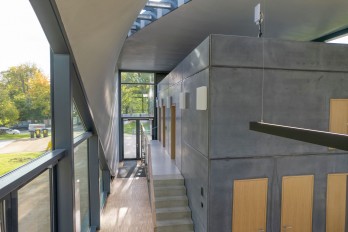Researchers develop new ultra-resistant and self-repairing concrete materials

New ultra-resistant and self-repairing concrete materials have been designed by a team from the Universitat Politècnica de València (UPV) and the Politecnico di Milano. In cracking situations, the new materials have 30% more durability compared to conventional high-performance concrete. In the event of a crack, they are able to repair themselves automatically thanks to the application of self-repairing techniques.
"These properties are possible mainly thanks to the design of the mixture and the use of components such as crystalline additives, alumina nanofibers and cellulose nanocrystals, which are capable of improving the ability of the material to repair itself", says Pedro Serna, researcher of the Institute of Concrete Science and Technology (ICITECH) of the Universitat Politècnica de València.
Regarding their applications, they are especially suitable for infrastructures subjected to extremely aggressive environments, such as constructions located in or near the sea, and for geothermal power plants as well. This is because of another advantage of these new cementitious materials that concerns the reduction of both ordinary and extraordinary maintenance work, being able to exceed the usual limits (50 years) of current design codes.
"In this project we are demonstrating how the durability of cementitious materials becomes a characteristic that can be designed through the synergy between the composition of the material and the structural conception. We have designed and are testing new cementitious compounds with the capacity for structural self-repair in the cracking phase, which is the usual state faced by a reinforced concrete structure", points out Marta Roig Flores, researcher at ICITECH.
In this way, ResHEALience represents a change from the concept of durability of the material understood as passive protection against external aggressions to an "active" vision of the same.
In the validation phase, the ultra-high-strength cementitious compounds developed in the project have been used to build six large-scale pilot structures that are currently being analyzed under real structural operating conditions. Two of them are in the Valencian Community (a float designed for floating wind towers, built in collaboration with Rover Maritime and the UPV, which is installed in the port of Sagunt, and a raft for mussels installed in the port of València by the Valencian company DRC), plus two in Italy, one in Ireland and one in Malta.
These structures are constantly monitored with UPV technology, specifically, by means of an extensive network of sensors supervised by a team from the IDM Institute, which makes it possible to verify their performance over time. It is a self-contained sensor system, configured like an electronic tongue, that provides real-time and continuous information on the durability of the structure. In addition, it helps pinpoint the risk of corrosion and the presence of aggressive agents that can affect structures.
"These data allow the experts in the field to verify the good condition of the structures, or, as the case may be, to adopt the necessary measures to prevent the damage from worsening, by using the most appropriate, economical, and less affected method of protection or repair on the operation of the structure", explains Juan Soto, a researcher at the IDM Institute (Universitat Politècnica de València).
Sources: phys.org, azobuild.com, interestingengineering.com
Image Gallery
Want to read more like this story?
Concrete Structures
Jan, 01, 2019 | EducationConcrete structures are constructions that utilize concrete as the primary building material. Conc...
Composite structures
Sep, 07, 2023 | EducationComposite structures refer to constructions that are composed of two or more distinct materials co...

Self-sensing and energy-generating concrete was created by engineers
Apr, 27, 2023 | NewsA new generation of concrete that is self-sensing and capable of generating electricity was recent...

10 state-of-the-art sustainable materials that will alter construction industry
Jun, 10, 2024 | NewsIn 2024, sustainable materials become state-of-the-art in construction since the construction indus...

The world’s first carbon concrete building constructed by researchers in Germany
Nov, 10, 2022 | NewsThe first building made of carbon-reinforced concrete was inaugurated in September after two and a...

Researchers use photos and new AI tool to calculate stress and strain fields of materials
Apr, 28, 2021 | NewsResearchers at Massachusetts Institute of Technology have developed a method to determine stres...

A novel material enables the assessment of concrete deterioration
Feb, 20, 2024 | NewsThe University of São Paulo's Physics Institute (IF-USP) in Brazil, in collaboration with counterpa...

How advanced finite element analysis can prepare buildings for extreme events
Nov, 14, 2024 | NewsWhile most structural analysis software can evaluate everyday stresses, they often fail to prepare...

Sustainable materials can be used in construction to decrease environmental pollution
Apr, 30, 2024 | NewsEfforts to reduce emissions in the building sector typically focus on operational aspects like heat...
Trending

New Release - STAAD.Pro 2025

Spectacular interchanges around the world

Melbourne Approves Skinny Skyscraper

STAAD.Pro 2024 New Release

China: Bridge collapse due to heavy rainfall




